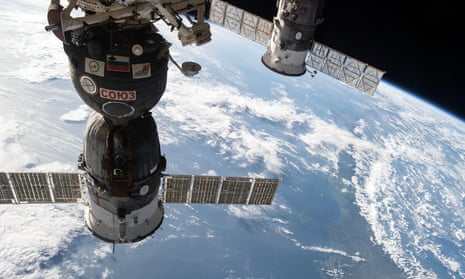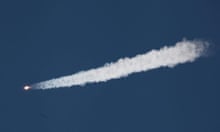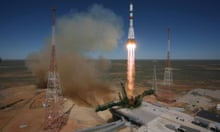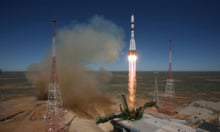A Russian spacecraft that broke down on its way to the International Space Station last week will burn up in a bright fireball as it falls back to Earth, according to the country’s space agency.
The uncrewed Progress 59P cargo vessel has been tumbling around the planet at about 17,000mph since it reached orbit last Tuesday. With the Russian Space Agency unable to regain control, the malfunctioning spacecraft began to spiral down to its inevitable destruction.
Roscosmos said the stricken ship was expected to burn up on re-entry between 11pm on Thursday and 3am on Friday UK time with only a few small pieces surviving the inferno and striking the planet’s surface.
Scientists tracking the stricken vessel with ground radar said 20-40% of the spacecraft could survive the intense heat of re-entry. The most likely part to withstand the inferno, at least partially, is the capsule’s docking mechanism, a sturdy 200kg metal ring the size of a rear tractor wheel.
Fully laden at launch, the vessel weighed 7,300kg, including more than a tonne of fuel and 2.5 tonnes of cargo. On that basis, between 750kg and 1.5 tonnes of the spacecraft body may survive re-entry and strike Earth. The debris is most likely to fall into the ocean, though some estimates suggest that fragments could be scattered over Africa or China.
Holger Krag, head of the European Space Agency’s space debris office in Darmstadt, said the risk of anyone being hit by falling parts of the Progress vessel are extremely remote. In six decades of spaceflight, no one has ever been hit by falling space hardware, he said.
“It doesn’t all come down in one piece. Most of the destruction happens between 80km and 70km high, and a very limited number of components have the potential to survive. These are scattered over a huge distance, up to 1,000km, so you might find a single piece every 100km or so,” Krag told the Guardian.
Every year 100 tonnes of space hardware re-enter the atmosphere, with the majority of it burning up before it hits the planet. Defunct satellites and spent rocket bodies fall to Earth every week. Larger items, such as the Progress cargo vessel, re-enter roughly once a year.
Space agencies in the US, Europe and Russia have been tracking the spacecraft, but its tumbling motion, speed and altitude mean there are uncertainties over where and when it will come down.
As the Progress vessel spirals down into the atmosphere it will undergo a massive deceleration from its orbital speed to about 180mph. Friction with the atmosphere will cause the spacecraft to heat up and break apart. Aluminium components will melt quickly, but stainless steel and titanium components will last longer.
The fireball could be bright enough to see in broad daylight, Krag said. But with more than 70% of the Earth’s surface covered by water, and only 3% of the land heavily populated, the chances are slim that anyone will witness it, let alone be struck by debris.
“It’s a complete waste of time to worry about this. There are daily risks that are much higher,” Krag said. “The risks of driving a car or flying in a plane are higher. Your chance of being struck by lightning is higher.”
Progress was designed to be a disposable cargo ship. In normal operations, it docks with the space station, is unloaded by the crew, and then jettisoned in a controlled re-entry over the Pacific to ensure any debris falls into the ocean. Because Russian space agency engineers have no control over the Progress module, they cannot purposely steer it into the ocean.
The vessel, carrying food, water and clothing to the space station, overshot its intended orbit on Tuesday and failed to establish communications with Russian ground controllers. An investigation into the cause of the malfunction is under way.
Only in its final hours will scientists have a clear idea of where and when the spacecraft will re-enter the atmosphere. But even then, it will be impossible to issue any precise warnings. “You can do nothing about it. We are not able to give any reasonable warning,” Krag said.
The European Space Agency’s predictions are based on re-entries of other spacecraft, because its scientists do not have the precise details of the materials and masses of the components used in the Russian spacecraft.






Comments (…)
Sign in or create your Guardian account to join the discussion